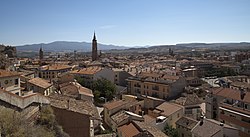Top Qs
Timeline
Chat
Perspective
Calatayud
Municipality in Aragon, Spain From Wikipedia, the free encyclopedia
Remove ads
Calatayud (Spanish pronunciation: [kalataˈʝuð]; Aragonese: Calatayú; 2014 pop. 20,658) is a municipality in the Province of Zaragoza, within Aragón, Spain, lying on the river Jalón, in the midst of the Sistema Ibérico mountain range. It is the second-largest town in the province after the capital, Zaragoza, and the largest town in Aragón other than the three provincial capitals. It is the seat of the comarca of Calatayud. Its population has been declining during the last decade due to migration.[2]
The town motto is Muy noble, leal, siempre augusta y fidelísima ciudad de Calatayud ("The very noble, loyal, always august and most faithful town of Calatayud").[3] The first democratic elections after Francisco Franco's regime were called for 15 June 1977. In Calatayud they were held one day earlier than all the rest of Spain, in order to prepare for a visit there by King Juan Carlos I.
Remove ads
Highways and railways
The town is located by the Carretera Nacional N-II highway, the Autovía A-2 and the N-234, among other local roads.
The AVE Madrid–Barcelona high-speed rail line,[4] as well as the Renfe line from Madrid to Barcelona stop in Calatayud.
History
Summarize
Perspective
The city was founded on the site of a Celt-Iberian settlement[5] by the Romans with the name Augusta Bilbilis and was the birthplace of the poet Martial in 40 CE.[6] The site of the ruins of Augusta Bilbilis are approximately four kilometers to the north of the modern city of Calatayud.[7] The modern town was founded by the Moors around the Ayyub castle, circa 716 CE.[8]

The name Calatayud came from the Arabic قلعة أيوب Qal‘at ’Ayyūb, "the qalat (fortress) of Ayyub". The ancient inhabitants of Bilbilis moved to the new site. Occupying a strategic placement between the central meseta of Spain and the Ebro valley, the city retained its importance in succeeding centuries. By the eleventh century a substantial Jewish community was present, surviving the reconquista until the expulsion of the Jews from Spain in 1492. Judaica texts from this era refer to Calatayud as קלע איוב, קלעה איוב, or קלעיה איוב (Qalʿah Ayuv, Qalʿ Ayuv, Qalʿiya Ayuv).[9] The city was conquered from the Muslims by Alfonso I of Aragón in 1119. Many surviving examples of mudéjar church architecture show that the Moorish influence lived on.[10]
During the Peninsular Wars a notable siege of French-occupied Calatayud led to its capture by guerillas in 1811.[citation needed] The city was the capital of its own province[11] in 1822–23, during the Trienio Liberal.

The town suffers from sinkholes.
Remove ads
Main sights
This section needs expansion. You can help by adding to it. (June 2010) |
- One of the most notable Mudéjar towers of Aragón is the 15th-century bell tower of the collegiate church of Santa María, which was built on the site of a mosque.[12] A Renaissance doorway was added in 1528.[13]
- Santo Sepulcro, built in 1141, and restored in 1613, was long the principal church of the Spanish Knights Templar.[13]
- This qalʿat is the biggest and oldest one on the Iberian peninsula.
- The church of "San Pedro" was founded by Ferdinand II of Aragón and it was there that the first cortes (parliament) of Aragon was held in 1411.[14]
Economy
The majority of employment is in the service sector and in agriculture. Agriculture consists primarily of apple and pear orchards,[15] although there are also some vineyards in the area).[16][17] Industry is much less developed, although there are two industrial estates (La Charluca and Mediavega) and the creation of a third is being studied.
Quarters and villages
- Quarters: Huérmeda, Torres and Embid de la Ribera
- Villages: Campiel, Carramolina, Marivella, Ribota, San Ramón and Terrer
Fiestas
- Easter
- Pilgrimage (romeria) in honour of el Cristo de Ribota, May 1
- Saint Íñigo's Day, June 1
- Saint Roch's Day, August 14–16
- Virgen de la Peña, September 8–12
Climate
Summarize
Perspective
Calatayud has a cold semi-arid climate (Köppen climate classification: BSk) with cool to mild winters and hot summers. Precipitation is irregular throughout the year, with spring being the wettest season and winter the driest, although August is the driest month. These precipitation patterns are typical of the semi-arid regions of Aragon. Due to its higher altitude compared to the Ebro Valley, the average annual temperature is lower, with colder winters and more pleasant summers.[18]
Remove ads
Traditions

There is a popular Spanish song that says (translated) "If you go to Calatayud / ask for Dolores (a popular female name) / she is a very nice girl / fond of granting favours" that captures the (traditional) fame of girls in Calatayud. Given that reputation, traditionally boys went to the town in order to "ask for Dolores" to be "favoured" by local girls. Nowadays this tradition has dismissed although in festivities, boys from the surroundings, even from Zaragoza, visit the town with that aim.[citation needed]
Remove ads
Sister cities
Calatayud has four sister cities:[20]
See also
References
External links
Wikiwand - on
Seamless Wikipedia browsing. On steroids.
Remove ads






